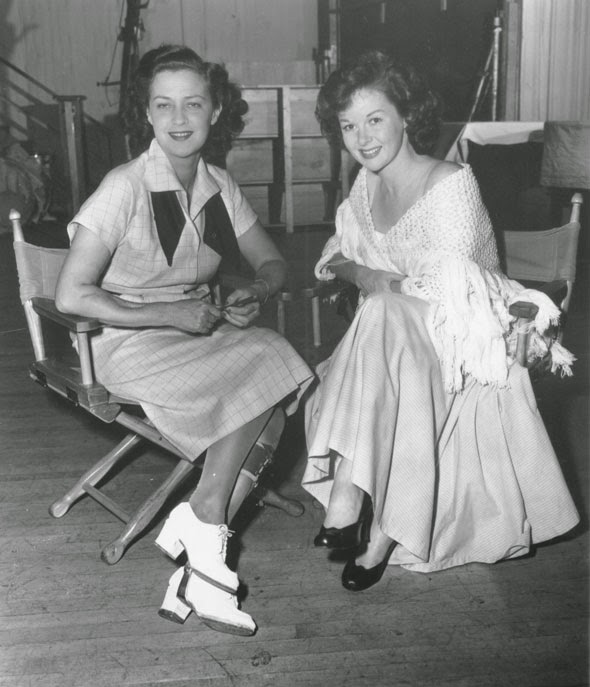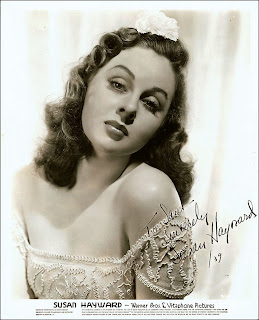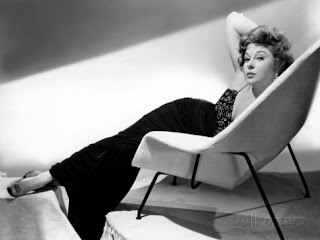"This I was born with: an imagination and a natural talent for lying. The perfect ingredients for an actor." -Susan Hayward
Edythe Marrener (Susan Hayward) was born on the 30th of June 1917 Saturday — ‘Saturday’s child has to work for a living.’ She was a tiny baby with bright hazel eyes, long brown lashes, with a tilt to her nose and her father’s flame colored hair.
The temperament that would so ably portray the courage of Jane Froman (herself crippled by a plane crash) in the screenplay 'With A Song In My Heart' may have begun to take shape on that sultry day in Brooklyn, when a little girl, against all medical advice and odds, struggled to walk again. “After she was back from the hospital,” Wally [Susan's brother] remembered, “the ladies from the church brought over a big bag of toys and she was allowed to open one each day that she was laid up in bed. She got a big kick out of that. It added a little surprise.” The reward for the pain and the suffering was her first taste of fame — and she liked it.
“The only way I knew how to protect myself,” Hayward later explained, “was to try to scare people before they scared me.” At Girls Commercial HS, she spent a great deal of time in the library, letting herself get caught up in the shining web of words that Thomas Wolfe spun for her. It was also in that library, she read for the first time, George Bernard Shaw’s play about Eliza the flower girl who becomes a great lady. When she read Pygmalion, she might have wished for some Professor Henry Higgins to come into her life and turn it around. She would be her own Professor Higgins and make herself into someone the whole world would know and admire. One of the women in the Dramatics Department was named Eleanor O’Grady. After she heard Edythe read for the first time, she called her into her office. “I believe you have real talent,” she told the girl.“Have you ever thought about making performing your career?” Had she ever thought —!
Susan Hayward: "If I were starting out in this day and age, I don’t think I would choose an acting career. The motion picture has all changed so tremendously. I think I’d be much more attracted to a career in something like archaeology or geology. Acting, no."
Acting upon the advice of a friend, she enrolled in the Feagan School of Dramatic Arts in Rockefeller Center, New York City. She went after the much talked about ‘experience.’ Lack of money resulted in her looking for work as a model.
At this time, there was a big boom in color photography and a natural redhead would be in. Edythe checked the yellow pages of the Manhattan phone book tearing off the listings for model agencies. On a hunch, she picked out what she thought were the best by their addresses. Acting impulsively on that same hunch she walked into the Walter Thornton Agency and asked for a job. One of Edythe’s girl friends from Astoria, Long Island, Margaret Lane reminisced about those days back in 1938. “We had to break into modeling the hard way then. Armed with a folio of our pictures and a scrapbook, we’d call on photographers, artists and fashion directors — and there were about 500 of them on the list. She became artist Jon Whitcomb’s most beguiling cover girl when he began to draw her wistful, saucy loveliness, and that was the start of her climb as a model.”
Agents from the Warner Brothers New York office offered her a $50 a week contract. On September 20, 1937 at $50 a week at the Warner Brothers Studios in Burbank, she began working as an extra on her six month contract. In her very first film, 'Hollywood Hotel' Louella Parsons, the powerful Hearst columnist would play herself in a movie based on her radio show. Next at Warners, she did a small bit as a telephone operator in the Bette Davis — Erroll Flynn potboiler The Sisters. The unbilled Susan Hayward in the film would be billed over the formidable Miss Davis the next time they were in another picture together: "Where Love Has Gone?" (1964)
At a starting salary of $250 a week, she made her first appearance in 'Beau Geste,' with Gary Cooper and Ray Milland. She received fifth billing but no mention in the reviews. From there, she went up to second place for 'Our Leading Citizen,' a minor effort, and dropped to fourth place in another poor film $1,000 'A Touchdown.' She began a new year and a new picture- 'Among The Living.' This part, as a small town vamp, seemed to portend the role of a vixen, which she was to portray so well throughout her career.
“All my life I’ve been terribly frightened of people. At the studio, it was the casting director, the cameramen, reporters and publicists who asked endless questions. I thought everyone was so brilliant and I felt so inadequate. At this party, those famous stars seemed so poised, so sure of themselves. Or so I thought. That’s when I got the idea that I should try to be like them.” People at the studio advised her to change because her attitude was wrong. She stopped being herself and tried to copy everyone else. She got so mixed up and became more confused than ever. Susan’s elocution lessons were laying on a finishing school accent over her pure Brooklynese. She joined the dozen promising players at Paramount — The Golden Circle. One of that group Richard Webb has not forgotten their first meeting; "I met up with her around 1940. She was a beautiful gal with a husky voice that turned me on. Susan was highly intelligent, very alert, and had a tremendous character."
Henry Hathaway, among others, agreed with that comment; “She never slept around, not at all, she wasn’t a flirt.” Susan handled men on their own terms, as she said,“I’ve been fortunate. I’ve always been liberated, but circumstances differ with each woman. I think that if a woman does the same job as a man, she should get the same respect but I personally don’t want to be in competition with a man. I would rather have him lead the way, with slight encouragement from me, of course. And some nudging to make sure he leads me in the right direction. But I have no desire to go out and run some man’s garbage truck.”
The Hollywood grapevine gossip was out. Hayward was good. One of the people who studied her work in Gregory Ratoff's "Adam Had Four Sons" was producer Walter Wanger. It was Wanger’s opinion that Susan darned near stole the picture from a darned good actress, Ingrid Bergman. Why did Paramount treat the whole matter as it were a freak of fortune and wasted her proven ability for another five years? This is one of the mysteries of the film business. Anyone can be ignored in Hollywood. More experienced actresses, noticing her fiery competence, felt threatened and pleaded with their directors not to be cast opposite her. People seemed to be always angry with her, a condition of life that she not only tolerated but actually appeared to thrive on. Her world, inside and out, was one of ire.
Susan Hayward: "I got my early training with some very good directors, William Wellman (Beau Geste) Gregory Ratoff (Adam Had Four Sons) De Mille (Reap The Wild Wind) — and they weren’t about to sit around and wait for me or anyone to get in the mood. I didn’t spend time between scenes joking with the crew or playing poker with the wardrobe women. I saved my energy so that when they said,‘Action!’ I was ready. I learned it because it was part of my trade. And by the same token, I learned to turn the emotions off just as quickly.”
Later, as movie magazine columnists would say, “He (Jess Barker) found his heart at the Hollywood Canteen — in Susan Hayward.” Another version is that Gregory Ratoff who had just completed 'Adam Had Four Sons' with Susan was on a trip to New York and caught Jess in a stage show. Seeing him, he thought that Barker would be the ideal leading man to play opposite Susan in real life. But whatever fates brought her and Jess Barker together in 1943, soon there was no turning back. She became pregnant by Barker that same year. While Susan was attracted by the up and coming actor, she didn’t consider him stable husband material and for a time toyed with the idea of having his child out of wedlock. When she finally went to the studio heads and told them of her condition, they informed her that if she didn’t marry Barker her contract would be terminated.
Jess hardly knew the emotional hurricane he was marrying, and little suspected the furies that would engulf him over the next ten years of his life. The marital storms between the Barkers began almost immediately. After three months, they broke up, only to have the studio decree that they reconcile for the sake of appearance. On February 19, 1945 at St. John’s Hospital in Santa Monica Susan gave birth to non-identical twins, Timothy and Gregory. Susan’s forced marriage to Barker was just an opening to the shattering circus of publicity that would later sweep over the couple.
In "Deadline At Dawn" (produced by Howard Hughes’studio RKO) she would play a dance hall girl who helps clear a naïve sailor of a murder charge. Director Harold Clurman spoke enthusiastically: "The whole experience is very vivid. Susan Hayward was very nice, but she was not in the best state there, because for some reason they (Paramount) had lost interest in her." Bill Williams, her co-star, who played the sailor in the movie couldn’t forget something that had happened; “She was a heck of an actress and a lovely human being. The last shot in the picture was when I was sitting in the bus with her; remember she was going to go with me. We had to kiss and it wasn’t right. Either I was holding her too tight or was a little too innocent about it. It went on about 3-4 hours. I said, “Gee Susie, it’s been a long time kissing you hasn’t it?” “Bill,” she said, “I gotta tell you something, you didn’t do anything for me, either.”
But it was her next Walter Wanger picture that was the turning point for Susan. Wanger bought a property, tailored made for her untapped talents: "Smash Up: The Story of a Woman". In it, she would portray the neglected wife of a crooner. It was said it was based on the life of Dixie Lee, the wife of crooner Bing Crosby.
Marsha Hunt, an excellent actress, co-starring as well in the picture recalled: “Sadly she had absolutely nothing to do with me. I never understood why. I finally realized it wasn’t personal, I couldn’t have offended her. This was a person so private and so closely involved with her job at hand that all relationships with others were nonexistent. Susan commented to the press; “Women should not drink. Women are not constituted like men; they’re too emotional and can’t take a lot of liquor. A woman spends hours making herself beautiful and then after two drinks her face falls.”
After the picture was in release, Miss Hunt met Susan in a department store in Beverly Hills. “She was dressed as for a garden party. I don’t mean she was badly dressed; she was extremely feminine, in a floating chiffon gown, wide picture hat, and little white gloves. She was gorgeous, a beautiful woman, and so gowned that your eye was fastened on her. She was standing in front of can openers, strainers, utensils, and kitchen supplies. When I glanced up from the counter where I was shopping, there she was facing me, without a sign of recognition.”
Someone who knew Susan well said, “She was painfully shy, a trait which takes the form of brutal frankness. She is almost sullen with strangers, making no effort to please them. She goes out of her way to make an unfavorable impression. She used to say, ‘you have to accept me at my worst or not at all.’ She didn’t want to wear glasses, and half the time she couldn’t make her way without them. That’s why she didn’t recognize people — she couldn’t see them.”
Her coldness, mingled with her usually superior work in front of the cameras, inspired a fearful awe. “She was a bitch!” said director Hathaway. “Anybody who is a bitch to work with has got to be a bitch to live with. That’s an inherent thing, a part of your make-up, to be an obstruction to everything. She was a little twisted, she was twisted in her walk, she always walked a little sideways, stood a little sideways, it’s a thing that was in her nature. It was in her head, her look, her walk, in the way she stood, that girl was twisted.”
In preparing for her role of Lillian Roth in "I'll Cry Tomorrow" (1955) directed by Daniel Mann, Susan had studied the mannerisms of seriously ill alcoholics and visited the cells of unfortunates in the Los Angeles County Jail. Through the bars of their cells, she has studied women with the “shakes.” In one scene, Susan had to play Lillian Roth at her absolute rockbottom, lost in her alcoholic obsession as she sat in the bar with the winos, it would be very important now not only to photograph Susan’s emotional involvement in that atmosphere but literally to photograph the reflection of the place as registered in her face.
The scene in the barroom is where Lillian, now a chronic alcoholic, is living in almost complete forgetfulness. She makes drunks laugh by reciting a childhood job seeking speech — ‘I’m Lillian Roth, I’m eight years old, I do imitations and dramatic parts’ — and the winos finally discover that this is the lady they remembered. They laugh at her while Susan sits there laughing too; and as she’s laughing big tears, like drops of blood, are pouring out of her eyes. It became one of the most unforgettable moments in the picture. Susan changed a lot during this period, very much aided by the story of Lillian Roth’s torment, and often went into long trances and became at times quite unreachable. “It was one of the great moments in my whole career,” Mann said about the barroom scene not simply because it was a classic moment of laughter and tears, but that she had the freedom and capacity to involve herself in a very personalized moment. Only an actress of great courage, talent and magic could have done it. It could have looked phony to be laughing and crying at the same time, big thing about Susan’s talent is that none of this was representative. What Susan did is what she experienced — that’s why the audience experienced it.”
In Susan’s tragic life, there was a deep understanding of irony and pain. A week later Susan Hayward tried to kill herself. She was alone in the living room of her house in Sherman Oaks on that Monday night, April 25, 1955. At some point, she took a large handful of sleeping pills, washed down with her usual bourbon, and decided at the last moment to call her mother. She always threw herself almost violently into her parts. She was an honest actress. -"Brooklyn's Scarlett: Susan Hayward: Fire in the Wind" (2010) by Gene Arceri
"When you’re dead, you’re dead. No one is going to remember me when I’m dead. Oh, maybe a few friends will remember me affectionately. Being remembered isn’t the most important thing, anyhow. It’s what you do when you are here that’s important." — Susan Hayward







_01.jpg)




























.jpg)


























